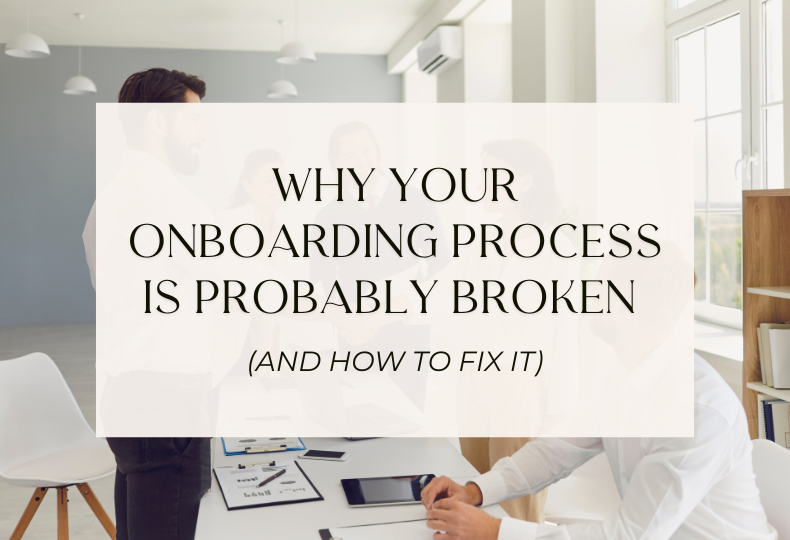Here’s a familiar story:
A new hire walks in on day one: bright-eyed, caffeinated, hopeful.
They’ve done their research. They know the company’s mission. They’re ready to dive in.
By lunch, that optimism is gone.
It slips out the door just that quickly because if the old adage “you only get one chance to make a first impression” holds true, your onboarding experience is truly the first opportunity for a new team member to catch a glimpse of what their days will look like.
So ya’ll, that first day (or week) should be so beautifully structured it runs like a well-oiled machine. There should be a plan. A welcome and introduction. An experience that sets the tone for their entire journey.
Sad to say, there are a lot of businesses out there phoning in their onboarding process.
No welcome. No roadmap. Just a login, a pile of paperwork, and a manager who’s too busy to say hi. Every question feels like an interruption. Every task feels like a mystery.
By the end of the week, they’re not leaning in, they’re checking out.
Sound harsh? It’s happening more than you think. And it’s costing you more than you realize in terms of employee disengagement and turnover.
Let’s be clear: Onboarding is not orientation. It’s your first and best shot to show people how your culture actually works.
If you get it wrong, no amount of swag or mission statements on the wall will save you.
Your Culture Starts at the Front Door
Onboarding is your culture’s front door. And right now, too many companies are slamming it shut in people’s faces.
If you’re serious about culture —scaling it, protecting it, living it —this is where you start. Not with ping-pong tables or “team building.” With clarity, connection, and consistency.
When new employees feel seen on Day 1, they show up on Day 2 ready to contribute.
When they feel ignored? They start planning their exit.
Day 2 Is Where the Truth Shows Up
I once had a friend tell me the story of her first day at a new company. She got a handwritten note from the CEO welcoming her to the team.
So she wrote him back.
That exchange stuck with her for 12 years because it was real. It wasn’t canned. It wasn’t corporate. It was culture in action.
That’s the kind of thing people remember. That’s the kind of thing people talk about.
So here’s your challenge:
Walk through your onboarding process like it’s your first day.
If it feels like stepping into a DMV instead of a team, you’ve got work to do.
How to Audit Your Onboarding Experience
This doesn’t need to be complicated. But it does need to be human.
Here’s where to start:
👉 Review your materials
Check your tone, not just your typos. Do your onboarding materials match your brand voice? Do they read like a welcome or a legal waiver?
Internal docs deserve your best storytelling, too.
Write your internal onboarding materials in the same voice you use with your customers. Why? Because your employees are your first customers.
That welcome guide? It’s a brand touchpoint.
That benefits explainer? Still a brand touchpoint.
If it’s got your logo on it, it should sound like you.
This is where HR and Comms need to team up.
Internal communication is a key part of the employee experience, and HR is often the messenger. Comms brings the voice, the clarity, the story. HR brings the moments that matter most. Together, they shape how culture is felt from day one.
If you’re building a people-first culture, alignment between HR and Comms isn’t optional. It’s foundational.
👉 Walk it yourself
Shadow a new hire or go step-by-step through the experience. Where do you feel stuck, unseen, or lost? That’s where you need to fix.
👉 Ask real questions
Send a short survey. Better yet, have a conversation. Ask:
- How did this experience make you feel?
- What helped you feel connected?
- Where did we lose you?
👉 Evaluate connection points
Do new hires meet actual humans? Or just fill out org charts?
Culture isn’t a vibe; it’s built through relationships.
👉 Assess support systems
Who’s their go-to when they’re stuck? Do they have one? If not, don’t be surprised when they disengage or drown.
👉 Look for early wins
Give them a meaningful way to contribute ASAP. Even a small task can build confidence and connection.
Who’s Doing It Well?
You don’t need to be Google or Netflix to build onboarding that works. But these companies are proof that when you invest in people early, they pay it forward.
Netflix:
Day one = clarity, autonomy, and support. Employees know they’re trusted and act like it.
Zappos:
They offer new hires money to leave if the culture doesn’t feel right. Bold? Yes. But it works. What’s left is a team that’s bought in.
Google:
Every new hire gets a buddy. Not just for lunch. They are assigned someone to guide them, answer questions, and help them get started on the right foot.
Hit the Reset Button
Here’s the bottom line:
If your onboarding process doesn’t reinforce the culture you say you have, it’s time to reset. You don’t need a full overhaul. You need intention.
Your onboarding isn’t a checklist.
It’s your first leadership moment.
And it sets the tone for everything that comes next.
